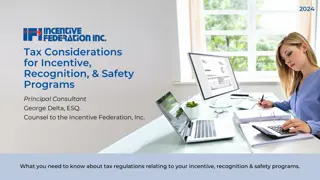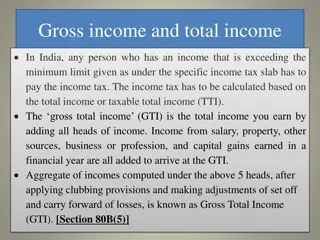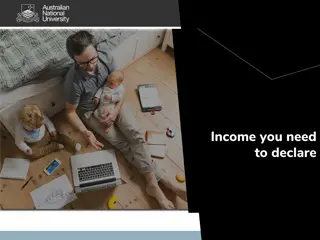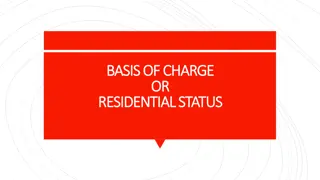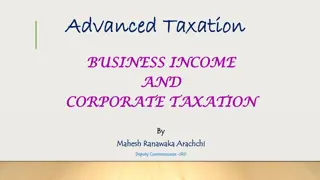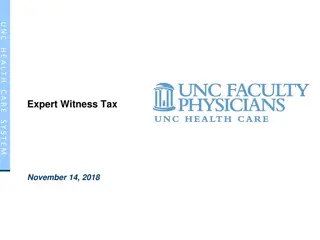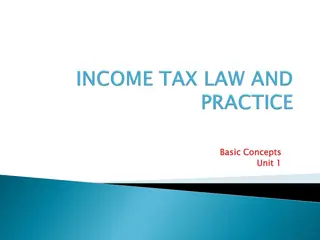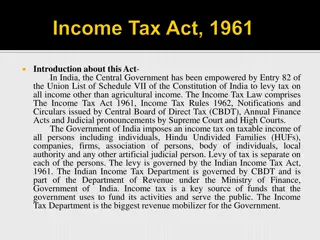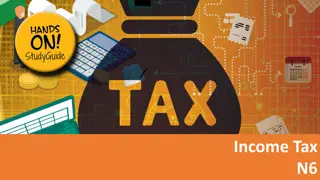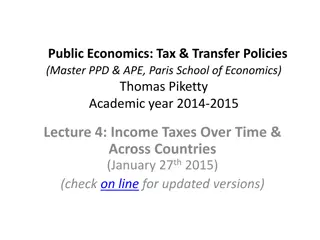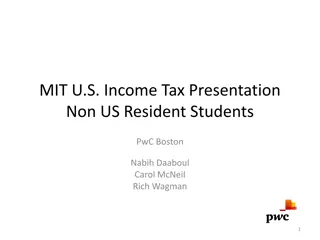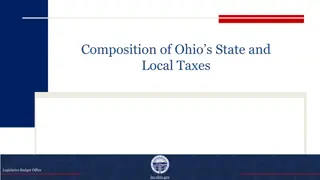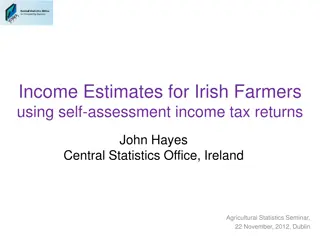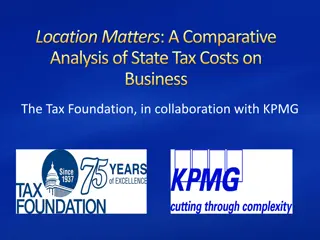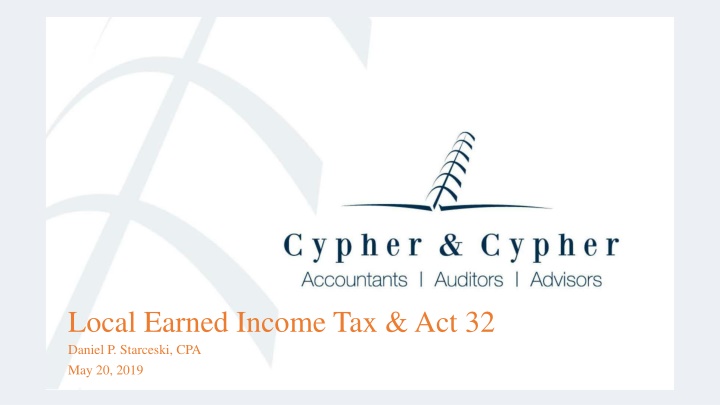
Local Earned Income Tax Act 32 by Daniel P. Starceski, CPA
Explore the details of the Local Earned Income Tax Act 32 presented by Daniel Starceski, a Senior Auditor and Accountant at Cypher & Cypher, CPAs. Learn about the history, rules, compliance requirements, and impact of Act 32 on the collection of earned income taxes. Discover how taxable income, tax rates, and assessment processes affect residents and non-residents. Gain insights into the complexities of determining tax rates based on residence and work location.
Download Presentation

Please find below an Image/Link to download the presentation.
The content on the website is provided AS IS for your information and personal use only. It may not be sold, licensed, or shared on other websites without obtaining consent from the author. If you encounter any issues during the download, it is possible that the publisher has removed the file from their server.
You are allowed to download the files provided on this website for personal or commercial use, subject to the condition that they are used lawfully. All files are the property of their respective owners.
The content on the website is provided AS IS for your information and personal use only. It may not be sold, licensed, or shared on other websites without obtaining consent from the author.
E N D
Presentation Transcript
Local Earned Income Tax & Act 32 Daniel P. Starceski, CPA May 20, 2019
Daniel Starceski, CPA Senior Auditor and Accountant at Cypher & Cypher, CPAs in Canonsburg Graduate of California University of Pennsylvania Member of the PICPA Pittsburgh Chapter Tax Committee Member of the PICPA Pittsburgh Chapter Executive Committee (May 2019)
Presentation Overview 1. Brief History of Earned Income Tax 2. General Rules and Overview 3. Compliance Requirements: Tax Collection Districts (TCDs) and Employers 4. Irregular Situations and Common Issues 5. Impact of Act 32 on Collection of Earned Income Taxes 6. House Resolution No. 291
Local EIT Overview Originally legislated through Act 511 of 1965 Act 32 of 2008 passed, effective in 2012 Consolidation of collectors, establishment of Tax Collection Districts (TCDs) Estimated losses on uncollected earned income taxes between $100 million and $237 million1 1 PA Legislative Budget and Finance Committee (2016). The Impact of Act 32 on the Collection of Local Earned Income Taxes. Harrisburg: Pennsylvania General Assembly, p.S-1.
Taxable Income W-2 wages are taxable Commissions, tips and bonuses are included Net Profit/Loss (Schedules C, E, F, K-1 or RK-1) Cannot offset wages with business loss Can offset with Schedule UE expenses Same as on PA-40
Earned Income Tax Rates Tax assessed by townships, boroughs, cities, municipalities, and school districts Total residential rates range from 0% to 3.6% Municipal and School District rates combine for total rate Total non-resident rates range from 0% to 2% Only municipalities are permitted to have residential rates Philadelphia not included in ranges above; not subject to Act 32
Earned Income Tax Rates Taxpayer pays the higher of 1) the resident rate of taxpayer residence, or 2) the non-resident rate of the taxpayer work location If non-resident work location rate is higher: resident municipality/school district receives their assessment first, remaining difference goes to work location municipality E.g. Steve lives in Canonsburg (1% resident rate) but works in Bethel Park (1.4% non-resident rate). Steve has 1.4% withheld and paid, but 1% goes to Canonsburg and 0.4% goes to Bethel Park.
Earned Income Tax Rates Employees that live outside of Pennsylvania but work in Pennsylvania pay the non-resident rate Out-of-state employers are required to withhold local earned income tax for Pennsylvania employees
Employer Compliance Residence Location
Employer Compliance Employment Location
Employer Compliance Certification
Compliance Requirements Political Subdivision Codes (PSD Codes) Six Digits, Three Sections Tax Collection District, School District, Municipality 70 01 02 Allegheny Central TCD Pittsburgh School District Pittsburgh City
Compliance Requirements Required to withhold and remit proper amount of taxes File within 30 days of the end of the quarter Some employers file monthly Out-of-State employers must follow the same rules as PA employers Employer is responsible for tax it cannot collect from the employee
TCDs & Tax Officers The following requirements are the responsibility of the Tax Collection District through the Tax Officer Some items subject to contract, others required by Act 32 Annual compliance audits required
Tax Collection Requirements Tax officer must oversee withholding and remittance requirements of employers (including Quarterly and Final Returns) Accept taxes from other TCDs Interest rate for a single tax year can not exceed 15% of the total tax due Reconciliation of State List to Tax Officer system to determine delinquencies and non-filers Usually two years behind (Tax officers will receive 2017 tax year information this summer)
Distribution Requirements Must be distributed based on actual report received, not estimates Permitted to make progress distributions Required to use PSD Codes Required to refund excess amounts Make reasonable effort to identify the PSD
Reporting Requirements Tax Officer to issue Monthly Reports to PSDs within 20 days of month end Use DCED prescribed report Reports must be generated for any month in which taxes are collected
Reporting Requirements Schedule B Distributions to Other Tax Collection Districts Taxes collected in one county that belong to another Includes counties with the same collector In transfers made to other TCDs, a report with certain fields is required Schedule C Receipts from Other TCDs Taxes received that were collected in another county Doesn t necessarily tie to Schedule B on other county Factor in delinquents The TCDs own county should not appear on their own Schedule B or C
Administrative, Investments and Bonding Administrative Tax Officers must be registered with the DCED Annual training courses Investments Generally subject to contract terms between TCD and Tax Officer Bonding Generally subject to contract terms between TCD and Tax Officer
Irregular Situations and Common Issues Improper PSD Codes Bordering Municipalities Out-of-State Employees Require COR form Require withholding Construction companies Work in one location for 90 days Home office location
Irregular Situations and Common Issues Differing withholding rates City of Pittsburgh City of Washington Multiple work locations Address Changes Change of address, change of COR, change of withholding
Irregular Situations and Common Issues Property split into multiple PSDs Temporary workers (foreign) Temporary residence used
Impact of Act 32 Study Performed by Legislative Budget and Finance Committee, published October 2016 Change from 560 EIT collectors to 69 tax collection districts, each with one collector Submit taxes to the TCDs tax collector who then distributes it to the correct collector Disagreements on certain interpretations Centax had issues remitting funds for its 10 TCDs on time $23 Million in the Bank, undistributed
Impact of Act 32 Drastic improvement in collections Average EIT Collected in 3 years before Act 32 - $2.002 Billion Average EIT Collected in 3 years after Act 32 - $2.205 Billion
Impact of Act 32 Report questioned whether Act 32 has simplified the system Conducted a survey of TCDs across the state No serious problems reported Obtaining revenues on a more consistent, even basis Still concern that employers do not understand and might not be in compliance Audits of employers conducted in Washington County
Impact of Act 32 SOC I Type I Reports Description of the organizations system prepared by management Statement by management that the description fairly presents the system and the established controls Auditor expresses opinion that the above to areas are valid SOC I Type II Reports More extensive testing of controls, at least a 6 month period Survey resulted in 21 require Type I, 22 require Type II, 13 do not require a SOC report, 5 didn t answer
House Resolution No. 291 Required the Department of Revenue to conduct a feasibility study for the state to take over the local earned income tax collection process Involved evaluation of current process Tax Officers and TCDs heavily involved
House Resolution No. 291 Three options as a result: Current process remains unchanged The Department of Revenue implements a state-wide process for EIT The Department of Revenue only assumes the front-end processing of EIT returns
Unchanged Process Recurring/Annual Costs - $45 million Pros Revenue has increased Improved cash flow Increased accountability Cons Inconsistency among the Tax Officers Broad range of fees charged by Tax Officers
PA DOR Implementation Recurring/Annual Costs - $36 million First Year Costs - $56 million Pros Lower future administrative costs Easier taxpayer compliance with EIT Increased electronic filing Cons Loss of local control Sunk costs by Tax Officers Loss of local jobs Loss of direct customer service High initial investment
PA DOR Front-End Only Recurring/Annual Costs - $61 million First Year Costs - $75 million Pros Easier taxpayer compliance with EIT Local Tax Officers remain in place Increased electronic filing Cons Administrative costs would be higher than the current process High initial investment
House Resolution No. 291 Option 2 would involve creation of a new local EIT bureau and create an estimated 215 jobs Option 3 designed to solve issue of filing multiple returns without removing the local power from TCDs and Tax Officers Of 118 respondents, 115 are against changing the current process and 3 are open for discussion

